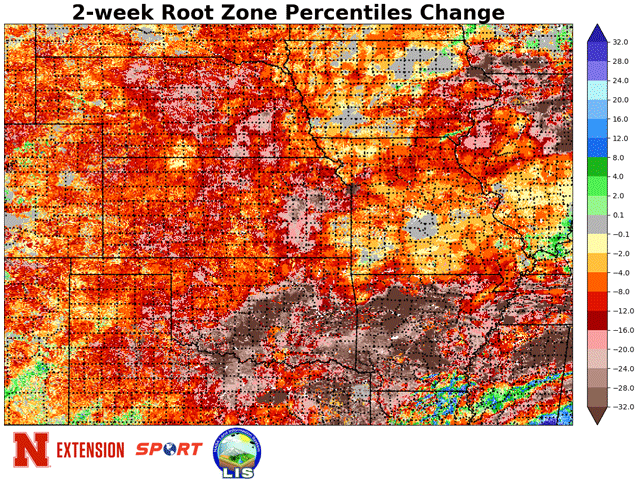Ag Weather Forum
Central US Had a Big Moisture Loss at Winter's End
Dry conditions in the central and south-central United States are growing more acute during this early meteorological spring (the months of March-April-May). A look at the change in soil moisture percentiles from the NASA Short-term Prediction and Transition Center-Land Information System (SPoRT-LIS) project shows that the Western Corn Belt incurred either moderate or major declines in root zone-level soil moisture during the period from Feb. 19-March 5, 2024. (The NASA SPoRT-LIS project provides high-resolution (about 3-kilometer) gridded soil moisture products in real-time to support regional and local modeling and improve situational awareness. The root zone is defined as the top 1 meter or 39.37 inches of soil.)
A graphic of the NASA SPoRT-LIS moisture analysis produced by University of Nebraska-Lincoln (UNL) Extension meteorologist Eric Hunt shows that the last two weeks of February brought severe root zone moisture declines in northern Illinois, southern Wisconsin, eastern Iowa, central and eastern Oklahoma, most of Arkansas, northern Mississippi, western Tennessee, and northeastern Texas. However, moderate root zone moisture declines were noted in almost all other locations in the selected portion of the contiguous U.S., including the Texas Panhandle, where recent very dry conditions supported the outbreak of the largest wildfire in Texas history. (See more on wildfires at https://www.dtnpf.com/…)
P[L1] D[0x0] M[300x250] OOP[F] ADUNIT[] T[]
A pattern of unseasonably warm weather at the end of the meteorological winter season (December-January-February) significantly contributed to the moisture loss. Average temperatures during the final 10 days of February through early March were from nine to more than 15 degrees Fahrenheit above normal in the central and south-central U.S. according to data compiled by the High Plains Regional Climate Center.
"The very warm February absolutely has contributed to the decline in soil moisture," said UN-L Extension meteorologist Eric Hunt in an email to DTN. "I'm still cautiously optimistic we will make continued improvement this spring. But I have been warning people that there may be trouble later this summer if we don't get reasonable moisture this spring," he said.
Spring precipitation and its impact on evapotranspiration (ET) are prominent in Hunt's assessment of dryness potential during the 2024 crop year. "IF we get ample rainfall in the next 90 days, as currently expected, then we should have a reserve of soil moisture to work with should we turn dry for a few weeks in early summer," he wrote in an Extension forecast comment. "This means crops and pastures can maintain relative health and evapotranspiration (ET) will only be reduced modestly instead of significantly ... A marginal reduction in ET means there is still some 'local source' of moisture to work with when frontal passages and shortwaves move into our region (making thunderstorms more likely)."
Moderate to locally heavy precipitation is forecast in the central and south-central U.S. during the next week. The moisture is much needed after the loss of root zone-level supplies during the past two weeks.
Bryce Anderson can be reached at Bryce.Anderson@dtn.com
(c) Copyright 2024 DTN, LLC. All rights reserved.




